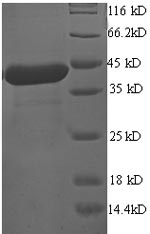Recombinant Human Programmed cell death protein 6 (PDCD6) is produced in E. coli and contains the complete protein sequence from amino acids 1 to 191. It carries an N-terminal GST tag, which makes purification and detection more straightforward. The protein reaches purity levels above 90% as confirmed by SDS-PAGE, suggesting it meets high-quality standards for research work. This product is intended strictly for research use only and is not suitable for therapeutic or diagnostic applications.
PDCD6, also called ALG2, is a calcium-binding protein that appears to be involved in several cellular processes, including apoptosis and signal transduction pathways. It seems to play an important role in regulating programmed cell death, which is likely essential for maintaining cellular balance. Research on PDCD6 may be particularly significant because of its involvement in cellular stress responses and potential connections to apoptosis-related disorders.
Potential Applications
Note: The applications listed below are based on what we know about this protein's biological functions, published research, and experience from experts in the field. However, we haven't fully tested all of these applications ourselves yet. We'd recommend running some preliminary tests first to make sure they work for your specific research goals.
PDCD6 is a calcium-binding protein involved in apoptosis that requires proper folding and calcium-binding capability for its biological function. While E. coli can successfully express some eukaryotic proteins, the correct folding and functional activity cannot be guaranteed without validation. The large GST tag (≈26 kDa) may cause significant steric interference with the native protein structure (≈22 kDa), potentially disrupting functional domains. No validation data (e.g., calcium binding assays, apoptosis functional tests) are provided. Therefore, the protein's folding status and bioactivity remain unverified without verification.
1. Protein-Protein Interaction Studies
If correctly folded, the GST-tagged PDCD6 could be used for pull-down assays to identify binding partners, as the GST tag facilitates immobilization. However, if misfolded, interaction domains may be altered, leading to non-specific binding or failure to recognize genuine biological partners. The large GST tag may also sterically hinder proper protein-protein interactions, even with correct folding.
2. Antibody Development and Validation
This application is suitable, as antibody generation primarily relies on linear epitope recognition. The full-length protein provides comprehensive epitope coverage. However, antibodies generated against potentially misfolded proteins may not optimally recognize conformation-dependent epitopes of native PDCD6 in biological contexts.
3. Biochemical Characterization and Enzymatic Assays
If properly folded, the recombinant protein could be used for biochemical characterization. However, if misfolded, data on thermal stability and cofactor requirements would misrepresent the native protein's properties. The GST tag may dominate biophysical measurements, complicating the interpretation of PDCD6-specific characteristics.
4. ELISA-Based Quantitative Assays
The GST tag enables technical feasibility for ELISA development through anti-GST capture. However, if misfolded, the protein may not present native PDCD6 epitopes accurately, compromising assay specificity for detecting endogenous PDCD6. Results should be validated with native protein standards.
5. Structural and Biophysical Studies
If correctly folded, structural studies could provide valuable insights. However, the large GST tag would dominate structural signals and likely interfere with crystallization or NMR analysis of PDCD6-specific domains. If misfolded, any structural data would be biologically irrelevant.
Final Recommendation & Action Plan
This GST-tagged PDCD6 requires validation before functional applications. Recommended actions: (1) Remove GST tag using protease cleavage and purify tag-free PDCD6 for critical applications; (2) Validate folding through biophysical methods (circular dichroism, size-exclusion chromatography) and functional assays (calcium binding, apoptosis assays); (3) For interaction studies, include tag-free controls and validate findings with alternative methods; (4) For structural studies, consider expressing tag-free PDCD6 or using cleavable tag systems. Antibody development can proceed, but requires validation against native PDCD6. Always include proper controls and consider eukaryotic expression systems for functionally validated proteins.






